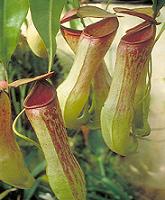By Prashant Mahajan
Insectivorous plants, also known as Carnivorous Plants, are interesting because of the wonderful methods they have adopted for catching their small animal prey. Although they trap insects and consume them, the prey never forms more than a very small fraction
of the food of these rare plants, all of which possess green leaves and obtain their main food supply in the normal way by photosynthesis. Why then do these plants trap insects? They are mostly found in swamps and bogs where there are few plants and animals.
This causes nitrogen deficiency in the soil. Insects and small aquatic animals have high protein content and so the insectivorous plants make up for deficiency of nitrogen, especially of protein, by digesting their prey. It is, however, quite possible for
them to live healthily without these animal-supplements to their food.
 Out of 450 species of carnivorous plants in the world, about 40 species are found in the Indian subcontinent. These are classified as Sundew, Butterwort, Venus' Fly-trap, water Fly-trap, Pitcher Plant and Bladderwort.
Out of 450 species of carnivorous plants in the world, about 40 species are found in the Indian subcontinent. These are classified as Sundew, Butterwort, Venus' Fly-trap, water Fly-trap, Pitcher Plant and Bladderwort.
Sundew is a small herb whose leaves are covered with numerous glandular tentacles, secrete a viscous fluid which glitters in the sun like dew drop. When the insect mistaking the glistening substance for honey alights on the leaf, it gets entangled. Like
Sundew, Venus'Fly-trap catches insects with its leaves. Water Fly-trap (Aldrovanda vesciculosa) is a widely distributed plant which is found in salt-lakes of the Sunderbans, Freshwater jheels of Bangladesh and in ponds of Manipur. Pitcher Plants are the most
remarkable of the insectivorous plants, which are found in tropics, especially in Asia.
One species, Nepenthes Khasiana, is found only in India in Khasi, Jaintia and Garo Hills. The pitcher vary from 10 to 20 cm in height and are brightly coloured. When young the mouth of the pitcher remains closed by a lid, which afterward opens and stands
more or less erect, thus leaving mouth open. The plant exudes sweet substance, which act as a bait for the insects. The insect attracted by the bright colour and sweet exudation, crawls up to the mouth and tries to get the sweet material present inside. In
doing so it slips inside and tumbles down through smooth and sharp hairs pointing downwards. The struggling insect is thus trapped, becomes tired out after a while, falls down into the liquid and is finally drowned. The liquid contains protein-digesting enzymes.
The insect is digested and ultimately the nitrogenous food absorbed.
Due to deforestation and over collection of insectivorous plants by botanists most of the plants are on the 'Endangered List' of Indian Flora.
(Source: Encyclopedia of Indian Natural History by R.E. Hawkins)